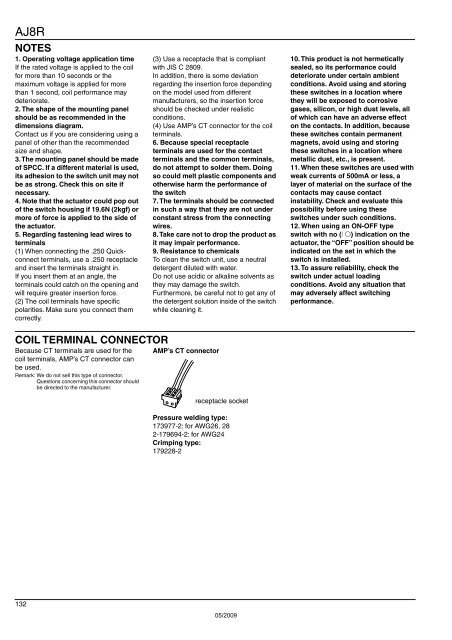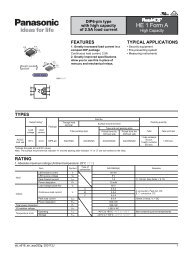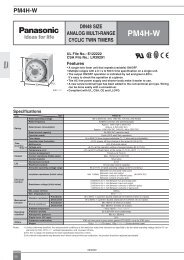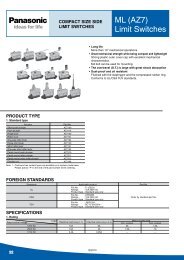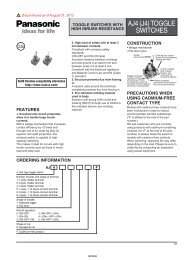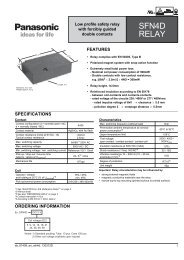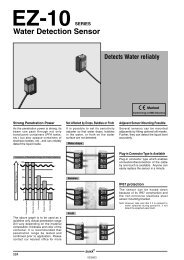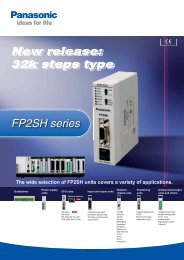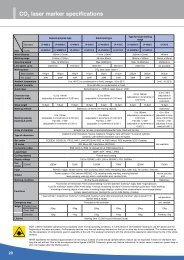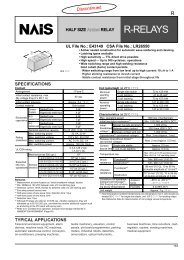T A B L E O F C O N T E N T S - Panasonic Electric Works Europe AG
T A B L E O F C O N T E N T S - Panasonic Electric Works Europe AG
T A B L E O F C O N T E N T S - Panasonic Electric Works Europe AG
You also want an ePaper? Increase the reach of your titles
YUMPU automatically turns print PDFs into web optimized ePapers that Google loves.
AJ8R<br />
NOTES<br />
1. Operating voltage application time<br />
If the rated voltage is applied to the coil<br />
for more than 10 seconds or the<br />
maximum voltage is applied for more<br />
than 1 second, coil performance may<br />
deteriorate.<br />
2. The shape of the mounting panel<br />
should be as recommended in the<br />
dimensions diagram.<br />
Contact us if you are considering using a<br />
panel of other than the recommended<br />
size and shape.<br />
3. The mounting panel should be made<br />
of SPCC. If a different material is used,<br />
its adhesion to the switch unit may not<br />
be as strong. Check this on site if<br />
necessary.<br />
4. Note that the actuator could pop out<br />
of the switch housing if 19.6N (2kgf) or<br />
more of force is applied to the side of<br />
the actuator.<br />
5. Regarding fastening lead wires to<br />
terminals<br />
(1) When connecting the .250 Quickconnect<br />
terminals, use a .250 receptacle<br />
and insert the terminals straight in.<br />
If you insert them at an angle, the<br />
terminals could catch on the opening and<br />
will require greater insertion force.<br />
(2) The coil terminals have specific<br />
polarities. Make sure you connect them<br />
correctly.<br />
(3) Use a receptacle that is compliant<br />
with JIS C 2809.<br />
In addition, there is some deviation<br />
regarding the insertion force depending<br />
on the model used from different<br />
manufacturers, so the insertion force<br />
should be checked under realistic<br />
conditions.<br />
(4) Use AMP’s CT connector for the coil<br />
terminals.<br />
6. Because special receptacle<br />
terminals are used for the contact<br />
terminals and the common terminals,<br />
do not attempt to solder them. Doing<br />
so could melt plastic components and<br />
otherwise harm the performance of<br />
the switch<br />
7. The terminals should be connected<br />
in such a way that they are not under<br />
constant stress from the connecting<br />
wires.<br />
8. Take care not to drop the product as<br />
it may impair performance.<br />
9. Resistance to chemicals<br />
To clean the switch unit, use a neutral<br />
detergent diluted with water.<br />
Do not use acidic or alkaline solvents as<br />
they may damage the switch.<br />
Furthermore, be careful not to get any of<br />
the detergent solution inside of the switch<br />
while cleaning it.<br />
10. This product is not hermetically<br />
sealed, so its performance could<br />
deteriorate under certain ambient<br />
conditions. Avoid using and storing<br />
these switches in a location where<br />
they will be exposed to corrosive<br />
gases, silicon, or high dust levels, all<br />
of which can have an adverse effect<br />
on the contacts. In addition, because<br />
these switches contain permanent<br />
magnets, avoid using and storing<br />
these switches in a location where<br />
metallic dust, etc., is present.<br />
11. When these switches are used with<br />
weak currents of 500mA or less, a<br />
layer of material on the surface of the<br />
contacts may cause contact<br />
instability. Check and evaluate this<br />
possibility before using these<br />
switches under such conditions.<br />
12. When using an ON-OFF type<br />
switch with no (I O) indication on the<br />
actuator, the “OFF” position should be<br />
indicated on the set in which the<br />
switch is installed.<br />
13. To assure reliability, check the<br />
switch under actual loading<br />
conditions. Avoid any situation that<br />
may adversely affect switching<br />
performance.<br />
COIL TERMINAL CONNECTOR<br />
Because CT terminals are used for the<br />
coil terminals, AMP’s CT connector can<br />
be used.<br />
Remark: We do not sell this type of connector.<br />
Questions concerning this connector should<br />
be directed to the manufacturer.<br />
AMP’s CT connector<br />
receptacle socket<br />
Pressure welding type:<br />
173977-2: for AWG26, 28<br />
2-179694-2: for AWG24<br />
Crimping type:<br />
179228-2<br />
132<br />
05/2009


